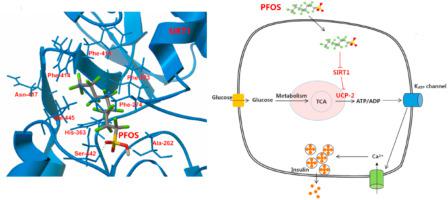Environmental Pollution ( IF 7.6 ) Pub Date : 2021-03-01 , DOI: 10.1016/j.envpol.2021.116840 Xiaoyu Duan 1 , Weijie Sun 1 , Hongwen Sun 1 , Lianying Zhang 2

|
Per- and polyfluoroalkyl substances (PFASs) are environmentally and biologically persistent anthropogenic chemicals linked to adverse health outcomes. Epidemiological data have revealed association between exposure to specific PFAS and disruption of insulin level in bodies. However, the effect of PFASs on insulin secretion and the responsible molecular mechanism are poorly understood. In the present study, we used perfluorooctane sulfonate (PFOS) as a representative PFAS family member to investigate its effect on the insulin secretion in mouse pancreatic β cells (β-TC-6). Our results showed that exposure to PFOS inhibited silent information regulator 1 (SIRT1) activity, and molecular simulation showed PFOS could fit into the pocket overlapped with the nicotinamide adenine dinucleotide (NAD+) binding cavity in SIRT1. PFOS exposure upregulated uncoupling protein 2 (UCP2) expression, and this upregulation was blunted in the presence of Ex-527, a SIRT1 specific inhibitor. The mitochondria membrane potential (ΔΨm), as well as the glucose-induced ATP production and Ca2+ influx decreased under PFOS treatment. PFOS continual exposure (48 h) impaired glucose stimulated insulin secretion (GSIS), while the gene expression of insulin was not significantly altered. Importantly, the SIRT1 activator and UCP2 inhibitor could partly reverse the PFOS-induced impairment of GSIS. Taken together, the results suggested that PFOS continual exposure could inhibit SIRT1 activity, and the SIRT1-UCP2 pathway mediated, at least partially, the PFOS induced GSIS impairment.
中文翻译:

全氟辛烷磺酸持续暴露通过 SIRT1 诱导的 UCP2 表达上调损害葡萄糖刺激的胰岛素分泌
全氟和多氟烷基物质 (PFAS) 是与不良健康结果相关的环境和生物持久性人为化学品。流行病学数据揭示了暴露于特定 PFAS 与体内胰岛素水平破坏之间的关联。然而,PFASs 对胰岛素分泌的影响及其负责的分子机制却知之甚少。在本研究中,我们使用全氟辛烷磺酸 (PFOS) 作为代表 PFAS 家族成员,研究其对小鼠胰腺 β 细胞 (β-TC-6) 胰岛素分泌的影响。我们的研究结果表明,暴露于 PFOS 会抑制沉默信息调节因子 1 (SIRT1) 的活性,分子模拟表明 PFOS 可以装入与烟酰胺腺嘌呤二核苷酸 (NAD +) SIRT1 中的结合腔。PFOS 暴露上调了解偶联蛋白 2 (UCP2) 的表达,而这种上调在 SIRT1 特异性抑制剂 Ex-527 的存在下被减弱。在 PFOS 处理下,线粒体膜电位 (ΔΨm) 以及葡萄糖诱导的 ATP 产生和 Ca 2+流入量下降。PFOS 持续暴露(48 小时)会损害葡萄糖刺激的胰岛素分泌(GSIS),而胰岛素的基因表达没有显着改变。重要的是,SIRT1 激活剂和 UCP2 抑制剂可以部分逆转 PFOS 引起的 GSIS 损伤。综上所述,结果表明,持续接触 PFOS 可以抑制 SIRT1 活性,并且 SIRT1-UCP2 通路至少部分介导了 PFOS 诱导的 GSIS 损伤。











































 京公网安备 11010802027423号
京公网安备 11010802027423号